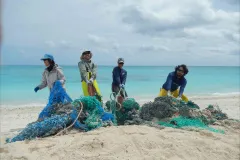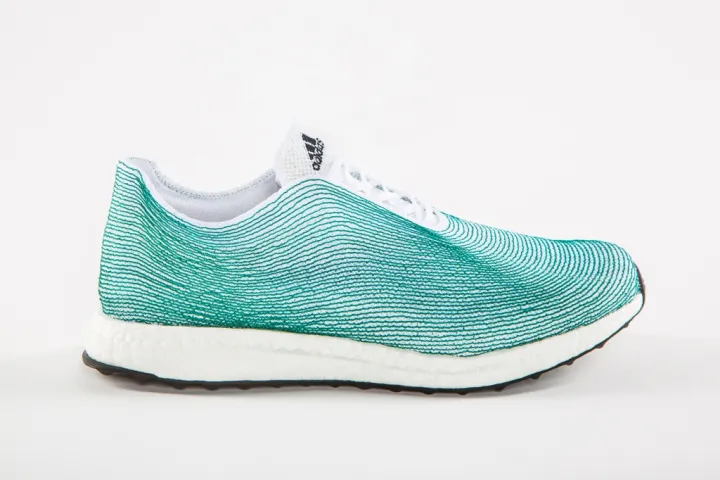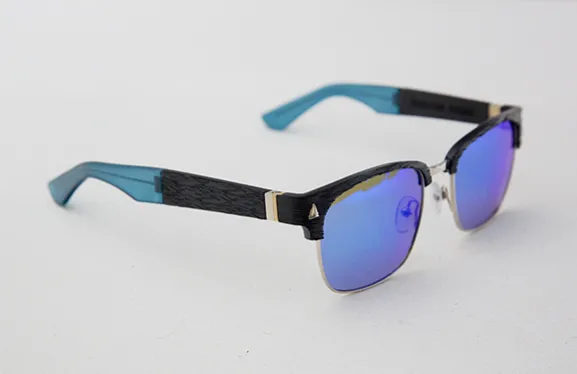Upcycled Ocean Plastic

The Possibilities Are Endless For Reuse of Plastic Ocean Trash
Today, most people have used and discarded something made of plastic. In the U.S., that item was probably either a grocery bag or a water bottle. According to EcoWatch, Americans use roughly 500 billion plastic bags and 35 billion plastic water bottles annually. On average, an American discards approximately 185 pounds of plastic every year.
Out of the millions of tons of plastic produced each year, only about 5 percent of it is reclaimed. A large amount of plastic, about eight million metric tons every year, ends up in the ocean, polluting the water and endangering marine life. But some companies are working to change these statistics.
The athletic brand adidas, in collaboration with the environmental organization Parley for the Oceans, created a running shoe made from marine plastic waste. To make the shoes, Parley and partners begin by collecting plastic waste from coastal areas, such as the Maldives. Collected plastic waste is then shipped to a supplier where it is upcycled and reworked into yarn that’s used to create the shoes.
For a time, adidas x Parley’s sneakers were on exhibit at the Cooper Hewitt Smithsonian Design Museum in New York. The upcycled running shoes were featured as a part of the museum’s exhibition “Nature—Cooper Hewitt Design Triennial,” which ran from May of 2019 through January 2020. The exhibit showcased sustainable design solutions to issues associated with climate change, as collaborators looked to nature as a muse and partner in their creations.
The exhibition explored several themes as they related to nature, including remediation and salvaging strategies. These themes are at the core of adidas x Parley’s shoe as its design strategy presents a solution to a major environmental issue and serves as a call to action to address the ocean’s plastic problem.
Adidas and Parley for the Oceans are not alone in their ocean plastic upcycling efforts. The sunglasses company Norton Point launched a line of three eco-friendly sunglasses in 2016. The glasses are made out of the plastic HDPE—high-density polyethylene—which was taken from the ocean and recycled. The eyewear line is part of the Martha’s Vineyard-based company’s “Sea Plastic Differently” campaign, which aims to build a more eco-friendly brand. Norton Point’s co-founders Ryan Schoenike and Rob Ianelli launched the campaign after discussing ocean pollution. “We were brainstorming, talking about how we could work on a project together,” Schoenike said. “We got to talking about this issue of ocean plastic and what a big deal it was.”
Ianelli has a background in eyewear, and Schoenike has a background in social impact and campaigning. So, the pair came up with a line of sunglasses made from ocean plastic. “We spent a lot of time investigating the concept, and really narrowing in on a supply chain and seeing if we could actually do it, and we realized that it was something we could definitely do,” Schoenike said. “And so, we launched it.”
There were still obstacles to face. How would the plastic get collected? Ianelli and Schoenike collaborated with The Plastic Bank, an organization where locals get paid a living wage for collecting plastic from the ocean and beach, to use as a source of plastic. “It wasn’t as simple as just going out and getting plastic, so we tried to find a partner and we came across The Plastic Bank in Haiti,” Schoenike said.
When Schoenike and Ianelli found a source of plastic, the two sent a sample to their manufacturer to work with. Initially, their manufacturers weren’t enthusiastic about the idea. “Even convincing them was really tough because essentially they were like, ‘So you want to make a product out of trash?’” Schoenike said.
After the manufacturers finally agreed to work with the plastic, they were stuck with another problem: HDPE is quite hard to work with. But, it was the only type of plastic from marine trash hard enough to make a durable frame, according to Schoenike. “There was a lot of experimentation—a lot of back and forth—until we came to a prototype that we felt was of the quality we wanted to put out,” he said.
Though the brand has finally found a successful process, the work isn’t over yet. “We still have an obstacle to go over in showing that more and more people are gonna buy these,” Schoenike said.
However, the future for recycled-plastic products looks promising. “I think there’s still a lot more to be done in terms of other products that can be made, and creating this greater awareness for people who aren’t fully aware of the issue and how it affects us,” he said.
Other companies are also tackling the ocean plastic issue and are taking steps to reduce plastic pollution. Unifi, a manufacturer that spins plastic into yarn, has been making graduation gowns out of recycled plastic that over 2.2 million students have worn. Sustainable skateboard company Bureo has launched a skateboard made from recycled fishing nets. The Toronto condo complex CityPlace installed carpets made from discarded fishing nets in its hallways, and a group called Net-works collects fishing nets and turns them into carpet tiles. Cleaning product company Method made a soap bottle out of recycled plastic. Clothing company G-Star RAW created a clothing line called RAW for the Oceans, which features clothes made partially from ocean plastic. The list goes on.
It doesn’t have to stop there. In a move to produce less plastic to begin with, Saltwater Brewery made edible six-pack rings out of barley to reduce plastic in the ocean and protect marine life. Also, energy bar company Clif Bar changed their packaging from shrink wrap to 100 percent recycled paperboard.
The example set by these companies should inspire us to make a difference ourselves. Individuals can make an impact too by being aware of the issue, using less plastic, recycling or reusing plastic, and talking about the need to reduce plastic pollution in the ocean. And who knows, maybe you can think up the next product to be made from ocean trash.
This story was updated in March 2020 with content from Hannah Knighton.
This story was made possible by a grant from the Smithsonian Women's Committee. http://swc.si.edu/about-grants




